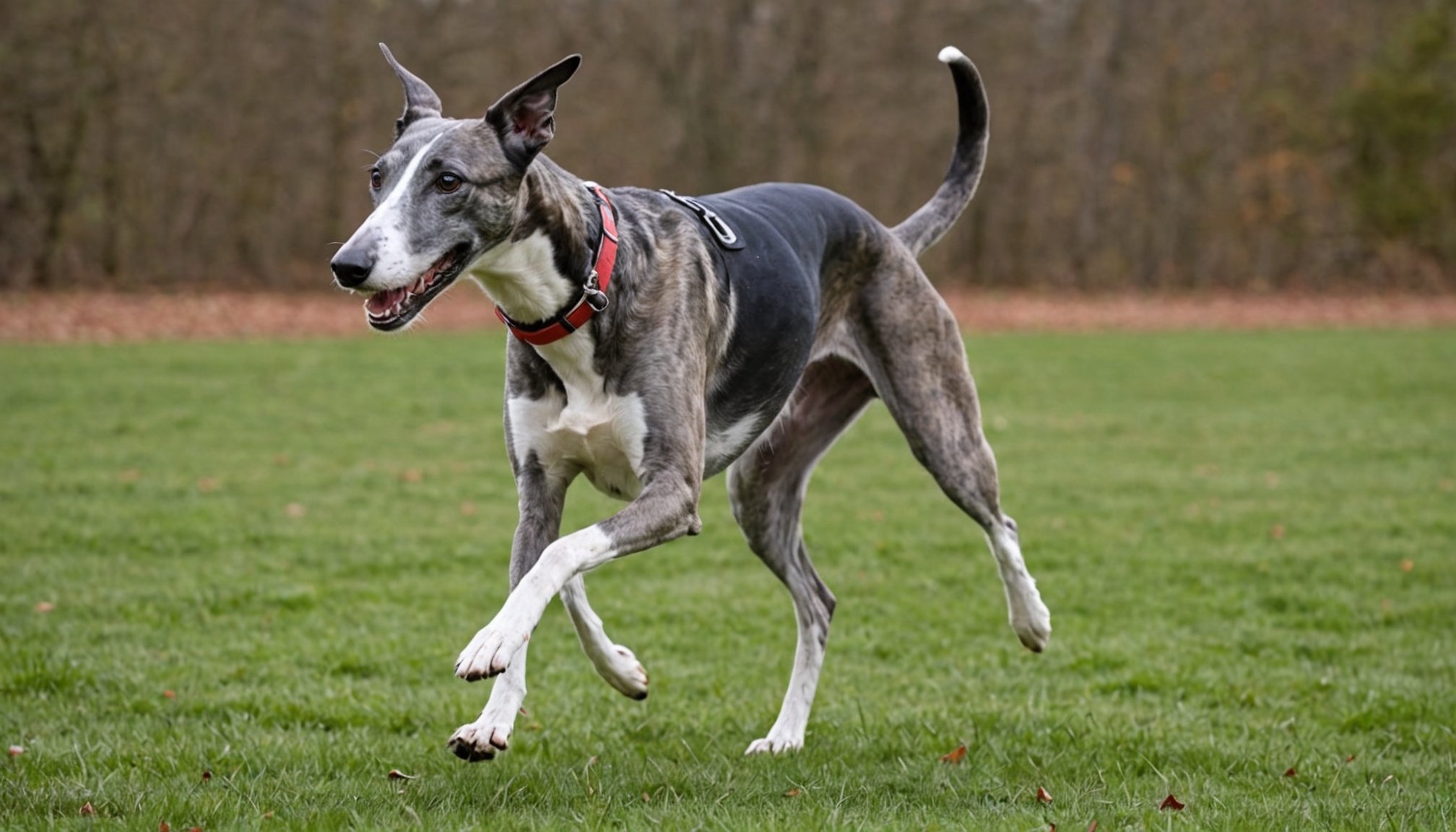Understanding Greyhound Recall Challenges
Greyhound recall challenges stem from the breed’s unique behavioral traits and natural tendencies. Known for their independent nature and strong prey drive, greyhounds often exhibit difficulties in traditional recall training. Their instinctual response to chase makes them highly susceptible to distractions in large open spaces, where they might spot potential prey or become intrigued by distant noises.
Training difficulties are compounded by these environments, as the vastness presents numerous distractions that demand the dog’s attention. For instance, a greyhound might get sidetracked by a moving object or other animals, making it imperative to manage their responses during training. Recognising these tendencies is crucial for developing effective recall routines.
In parallel : What specific dietary needs should I consider for my senior dog to maintain their health and well-being?
Individual responses to training vary significantly among greyhounds, requiring a tailored approach. While some dogs may quickly adapt to recall commands in a controlled environment, others might need more time and patience, especially in stimulating settings. Understanding your dog’s personality can guide you in choosing the right training methods, highlighting the importance of focusing on consistency and patience.
Thus, owners must acknowledge and leverage these unique characteristics in designing a recall training strategy that resonates well with their greyhound’s nature and tendencies.
Have you seen this : How can I choose the right toys for my dog based on their age, size, and play style?
Essential Training Techniques
To master greyhound recall challenges, it’s crucial to employ effective recall training techniques. A solid foundation is indispensable for training success. Begin with brief, straightforward commands to establish understanding. Consistently using the same word or whistle ensures clarity and fosters routine.
Establishing a Solid Foundation
Building a reliable recall begins with patient teaching of fundamental skills. Use expert methods to ensure commands are clearly associated with returning to the owner. Regularly practicing in enclosed areas helps create a secure environment which results in increased confidence and understanding for the dog.
Leveraging Positive Reinforcement
Positive reinforcement is key in maintaining a greyhound’s enthusiasm. Reward successes immediately with treats or affection to encourage repetition of the desired behaviour. This approach strengthens the bond between trainer and dog, making training strategies more enjoyable and effective.
Gradual Exposure to Open Spaces
After mastering the basics, gradually introduce training in large open spaces. Start with short distances where distractions are limited, and progressively increase the complexity and distance. This incremental exposure helps in maintaining focus and enhances the dog’s ability to manage distractions in diverse environments. Recognising how your greyhound reacts during training can guide the gradual introduction of more challenging scenarios.
Utilizing Reward Systems Effectively
Efficient use of dog training rewards is integral in nurturing motivation techniques for your greyhound. By understanding the most suitable types of rewards, you directly enhance training outcomes and boost your dog’s performance.
Types of Rewards
Successful training hinges on the type of positive reinforcement given. The most effective rewards for greyhounds often include small, tasty treats, verbal praises, or affectionate gestures. These not only foster a positive training environment but also strengthen the bond between you and your dog.
Timing in Reward Delivery
The role of timing is critical; delivering rewards promptly ensures your greyhound associates the desired behaviour with the reward. This association forms the foundation for mastering recall commands. Delayed rewards may confuse your greyhound, leading to inconsistent performance.
Fading Out Treats
Balancing reward strategies includes gradually reducing treat dependency while maintaining motivation techniques. Start by substituting treats with verbal praise or affection, ensuring your greyhound remains engaged and enthusiastic. This transition helps the dog rely less on treats and more on the intrinsic joy of pleasing its owner, sustaining effective training.
Managing Distractions During Training
Maintaining focus during training hinges on effectively minimizing distractions, especially in environments ripe with potential disturbances. Greyhounds, known for their acute senses, can easily become distracted when training in open spaces.
Identifying Common Distractors
Recognising the most frequent distractors helps hone a more focused training approach. These might include other animals, vehicles, or distant sounds. Visual stimuli like moving objects are particularly captivating due to the greyhound’s prey drive.
Techniques for Reducing External Stimuli
Adopting techniques that reduce external stimuli is fundamental for successful training. During initial sessions in large areas, select quieter times or locations to limit distractions. Creating a boundary using physical markers can also delineate training zones, helping to maintain the dog’s attention on the task.
Creating a Controlled Training Environment
Creating a controlled training environment is crucial for establishing initial recall reliability. Begin in enclosed spaces where visual and auditory hindrances are manageable. Gradually introduce mild distractions while reinforcing behaviour with consistent rewards and commands. This gradual exposure fosters resilience against distractions, enabling greyhounds to better manage their inherent instincts in different settings. Through targeted efforts in controlled environments, trainers can significantly improve training outcomes amidst inevitable stimuli.
Implementing Safety Measures
Ensuring safety during greyhound recall training is paramount. Greyhounds require specific safety gear to accommodate their unique physiology and enthusiastic response. A proper harness, rather than a collar, is essential as it distributes pressure and prevents potential injuries. Moreover, using a long lead in large open spaces maintains control while allowing freedom.
Best Practices for Leash and Harness Usage
Select equipment designed for dog safety, such as padded harnesses, which offer comfort during leash training. Regular checks on gear fit and condition prevent accidental escapes. Familiarize your greyhound with the harness and lead in a non-distracting environment to build comfort before facing open spaces.
Guidelines for Safe Recall Practice
When training near other dogs, recall training safety should be prioritized. Ensure space between your greyhound and others to avoid overstimulation. Gradually increase social exposure as they become more reliable in their recall response. Practicing controlled greetings is a valuable step to promote positive interactions and assert recall commands effectively.
The structured application of safety measures during training can dramatically enhance both the training experience and your greyhound’s safety, building a secure foundation for their successful recall development.
Building Consistency in Training
Establishing consistency in dog training is crucial for reinforcing recall behaviours in greyhounds. Achieving this requires a structured approach and a commitment to regular habits.
Training schedules should be balanced yet flexible, incorporating varying sessions to cater to both controlled and open environments. This variation prevents greyhounds from becoming too habituated to one setting. For instance, introducing brief sessions outdoors can mirror potential real-world encounters, fostering adaptable responses.
Regular practice ensures the development of reliable recall skills. Scheduling sessions multiple times a week encourages learning and retention. Aim to train at different times of the day to prepare your greyhound for diverse conditions and distractions.
Task repetition is fundamental for embedding commands and signals. Use consistent words or signals to avoid confusion, and reinforce behaviours with immediate praise or rewards. Consistent signals help greyhounds quickly associate the action with the desired outcome, enhancing recall effectiveness.
Finally, evaluate progress periodically. Monitor your greyhound’s response in varying environments and adjust training techniques if necessary to maintain an engaging and effective training experience, ensuring a reliable recall every time.
Real-Life Examples and Case Studies
Sharing dog training case studies provides invaluable insights into refining greyhound recall techniques. These success stories showcase the efficacy of tailored approaches and highlight both challenges and triumphs.
Documented Success Stories
A remarkable example involves a rescued greyhound named Daisy. Initially overwhelmed by her greyhound recall challenges, her owners employed persistent recall training techniques. By gradually introducing her to large open spaces and using expert methods, Daisy’s recall improved dramatically. Her owners focused on consistent training coupled with diverse environments, leading to reliable recall performance.
Lessons Learned from Failed Attempts
Conversely, another case highlighted pitfalls of insufficient practice. Hector, a greyhound, experienced slow progress due to erratic training routines. His owners overlooked structured training schedules, resulting in training difficulties. This underscored the necessity of disciplined, consistent training and patience in managing failures.
Expert Insights from Dog Trainers
Renowned trainers stress the importance of adapting techniques to each dog’s unique disposition. A multi-faceted strategy combining focused training and environment control can navigate greyhound recall challenges. Experts advocate for patience, commitment, and recognizing individual dog responses, helping to transform challenges into success stories. Such practical examples offer hope and guidance for greyhound owners striving for better recall outcomes.










